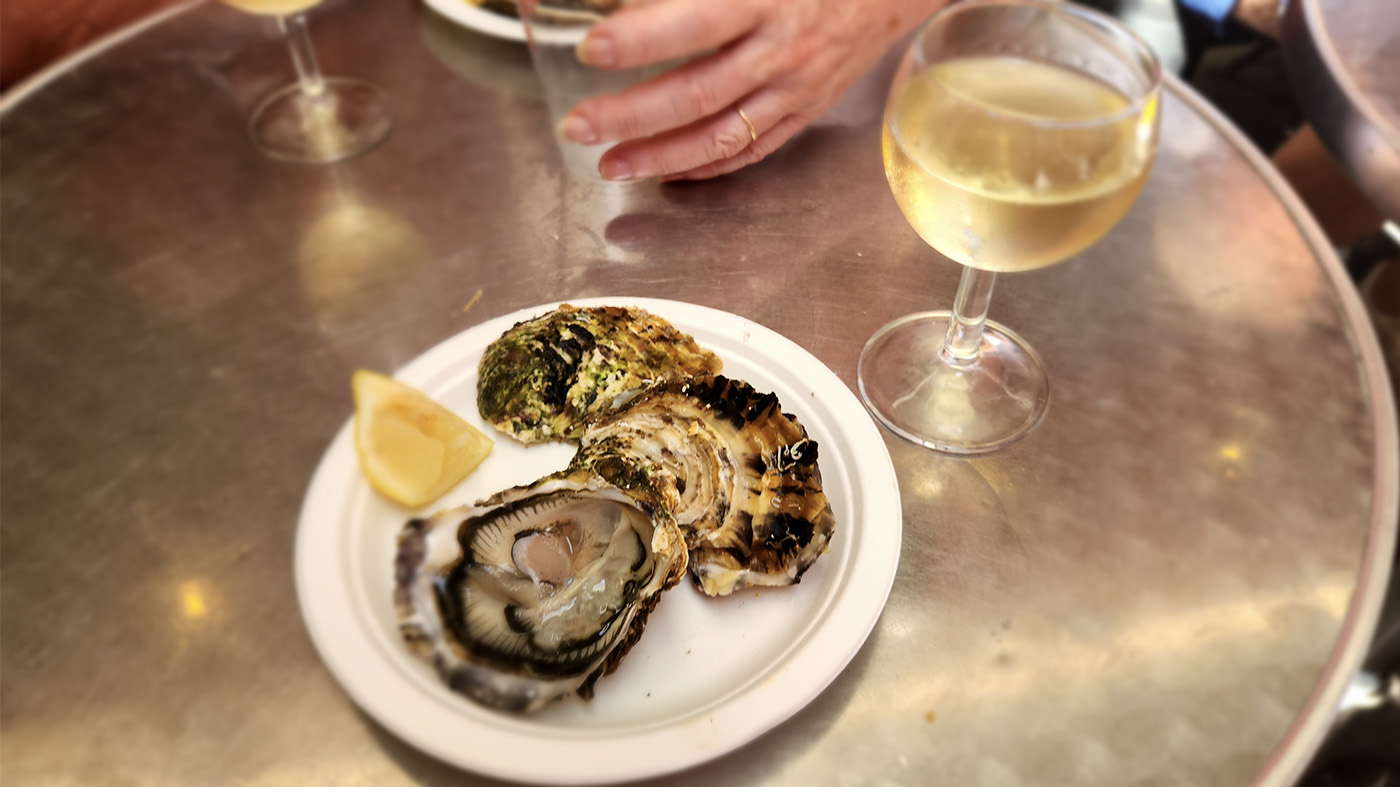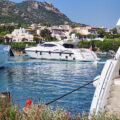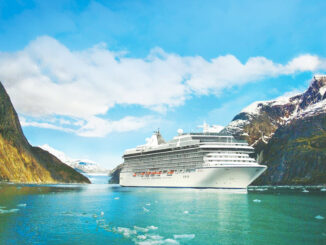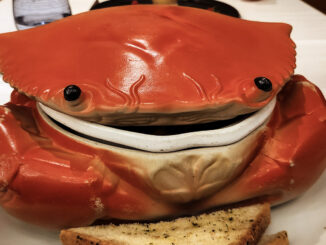
We’re ready to devour the scrumptious catches of one of France’s seafood capitals. The small size of our cruise yacht World Traveller gives us the advantage of docking an easy stroll from the middle of Sète, a gorgeous southern French city that larger ships never visit.
And the guests heading out for an Epicurean Expedition market tour and gourmet tasting in the historic city of 45,000 have the streets to themselves on an early Sunday morning.
Super, but Mon Dieu! There is a problem. It’s Sunday and Les Halles, the main market we’re supposed to visit, is fermé le Dimanche: Closed on Sundays.
But nothing can stop the forces of Atlas Ocean Voyages on an Epicurean Expedition. Our intrepid gourmet tour guide takes us out as planned , to peek into kitchens of shoreside restaurants and explore the docks of the fishing fleet that brings in 10 tons of fish every day. The 90 local species include red tuna, monkfish, mullet, capelin and octopus. And we’ll do a scrumptious tasting of the local specialty, fresh oysters that are farmed in a lagoon along the rocky coast.

We see how rocky the coast can be, we walk along the oceanfront St. Louis breakwater, built when the city was founded in 1666 to protect the port from severe storms that can race in from the southeast. A few masochists have actually clambered along the hefty boulders of the storm wall and are trying to enjoy sunbathing there in the relentless sun.
Fortunately, beach lovers have miles of sandy options nearby on a long spit fringing the lagoon that farms more than 13,000 tons of oysters each year. (And further along the coast if you’re up for the challenge is a world-famous nude beach at Cap d’Agde).

On our tour, we learn a lot about Louies. The breakwater and its iconic lighthouse were named St. Louis for King Louis IX, a thirteenth century Crusader who converted Sultans on his way to the Holy Land. He’s the only French king the Catholic Church recognizes as a saint, and also the namesake of that city in Missouri
But another Louis had the greatest influence on Sète: the Sun King Louis XIV, who in 1666 ordered what was then a humble fishing port on the Languedoc coast built up with pretentions of grandeur. A prime improvement was the Canal du Midi, dug through the center of town. Prominent brass plaques on its ornate bridges hail the Sun King.
Naturally, like every other place in the world criss-crossed with canals Sète has developed a nickname “the Venice of Languedoc.” There are no gondolas in this Venice, but hundreds of pleasure boats line the banks because by water is the easiest way to get around the town.
And the streets along the canal are gourmet delights. They’re lined with restaurants serving local dishes that mix influences of Italy, the province of Languedoc and the Occitaine region. Local specialties include tielle, a pie made with calamari, tomato sauce and spices and macaronade is a traditional dish of made from macaroni and meat.

But seafood is still the star attraction. “These could really become addictive,” one of our tour guests exclaims as we plunge into plates of oysters in their ornate shells at tables at the Bistrot du Marche across the street from Les Halles. These big huitres were literally harvested this morning and you’d be hard pressed to find them fresher anywhere in the world. Indeed, this entire street is lined with outdoor tables for indulging your oyster addiction. Half a dozen along with a glass of the refreshing local wine cost a mere 10 Euros.
In addition to oysters’ reputation for aphrodisiac effects, the restaurant presses the point. Dessert is a local biscuit, zezette , with an uncanny resemblance to a male appendage.

We learn fun facts about oysters from our Atlas Ocean Voyages tour guide. Oysters and mussels are grown by 800 farms on 2,800 shellfish rafts in the Thau lagoon. A single adult oyster can filter up to 50 gallons of water a day. That’s about as much water as you use in a 10-minute shower. And no wonder Louis Quatorze was interested in oyster-rich Sète: He is said to have had the local oysters brought continually to Versailles or wherever he was and was known to eat as many as six dozen at a time.
Our Sunday visit turns out to be fortuitous because it’s also when Sète’s traditional water jousts between rowing teams in special boats compete to topple their opponents into the drink. It’s been an annual August festival isince the first water joust took place in 1666, to inaugurate the opening of Sète port.
The rules of water jousting haven’t changed much since then. Two teams compete on long boats with 10 oarsmen, a drummer and an oboist playing rhythmic medieval tunes. A blue team is composed entirely of bachelors, and the red team made up of married men and the jouster on reach boat stands on raised platform at the end of the boat carrying a lance about 10 feet long to try to knock over the competing jouster. Could that be the origin of the saying I wouldn’t touch him with a 10 foot pole?
The jouters are protected only with a wooden breastplate and a shield called a pavoir to deflect the lance as the teams row to the middle of the canal to do battle after battle. It takes a direct hit on the shield to topple an opponent as the boats collide. When a loser topples into the canal, rowboat teams move in to pull him out, but not without ample hazing. The winners gets bragging rights and a chance to do another battle. It’s all in great fun and on this very hot day, it’s clear the losers appreciate their cool dip.
Sadly, we couldn’t take along bags of oysters as we head back to World Traveller. But no worry, the crew is waiting at the gangway with plates of treats and glasses of local wines along with the drink of the day, a Sète sunset, to savor as we share stories of the unexpected but successful Epicurean Expedition.
Atlas Ocean Voyages’ Epicurean Expeditions probe the culture of a destination with excursions that may include sampling specialty cheeses or chocolates, attending a demonstration at a cooking school, or tasting regional wines, spirits or coffees. In 2025, World Traveller will be doing Epicurean Expeditions in the Mediterranean, followed by a summer season in Scandinavia and Iceland.
Story by Wallace Immen, The Cruisington Times









1 Trackback / Pingback
Comments are closed.